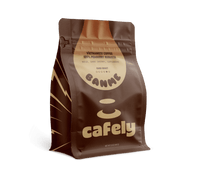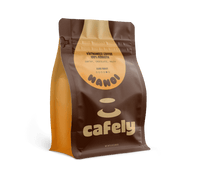You may have seen it mentioned on the packets of coffee beans or grounds in the store but not really understood what it means. So, what exactly is French roast coffee?
In short, a French roast is a dark roast coffee with a strong, caramel-like flavor. However, there’s more to it than that.
In this article, we’ll take you through how this coffee roast type is defined, how it‘s made, and what it tastes like.
What is French Roast Coffee?
French roast is a roasting method for coffee beans that emerged during the 1800s in France — this is how it earned its name. This coffee type uses arabica beans, but the resulting cup isn’t typical of arabica at all.
French roast coffee beans are dark and produce a complex brew with a caramelized flavor and a slight bitterness — although not as bitter as other dark roasts. French roast coffee is roasted at high temperatures for quite some time — some coffee aficionados even consider it to be “burnt.”
Flavor Profile of French Roast Coffee
The best way to describe French roast coffee is through its flavor. It’s bold and intense, with almost all of the natural acidity of the coffee beans having been burned away. This creates a coffee with a thin mouthfeel and smoky sweetness, with some charred and bitter notes.
How is French Roast Coffee Made?

How the beans are roasted gives French coffee its unique characteristics.
Most coffee is typically roasted at around 220 degrees Celsius (426 degrees Fahrenheit). But, with a French roast, the temperature is kicked up dramatically to 240 degrees Celsius (464 degrees Fahrenheit). This steep increase in heat is what helps the roast to achieve its signature charred smokiness.
French roast coffee is also characterized by something called a double crack. When coffee is roasted, it creates a cracking sound. The first crack occurs at 196 degrees Celsius (385 degrees Fahrenheit) — this is caused by the moisture evaporating as the beans expand.
Light roast coffee is removed from the heat immediately after the first crack. Medium roast coffee is removed a while after the first crack. French roast and other dark roast coffees are left to increase in temperature until they reach the second crack.
This is when the coffee beans start to break down and become brittle, indicating they are close to being burned. It’s at the end of the second crack that roasters deem the batch “French roast.”
How Popular is French Roast Coffee?
Although it’s one of the most popular roasting styles across the world and a mainstay in many grocery stores, French roasts divide opinions.
It's the intensity of the roast that leads some people to love French roast coffee and others to hate it. The natural aromas and flavors of the beans used are all but lost when being roasted this way, giving the resulting coffee a strong, bold flavor.
Some people enjoy the smokey, strong flavor of a French roast, while others believe the complex flavors of the arabica coffee are best presented in a medium to medium-dark roast.
How to Prepare French Roast Coffee
French roast coffee is best prepared using a drip coffee maker, a moka pot, or an espresso machine. Because the roasting process is so harsh on the beans, it’s rarely made with a pour-over setup — a delicate brewing method that preserves the unique notes of light to medium roast coffee.
The most popular way to prepare French roast coffee is in a French press.
Unlike paper drip filters and pour-over filters, the French press uses a metal mesh filter, which creates a rich, dark, full-bodied cup.
Making coffee with a French press is simple:
Grind the Coffee: First, the French Roast coffee is ground medium-coarse. Around 17 grams (2–3 tbsp) of coffee is used for every 7.5 oz (220 mL) of water. Add the Coffee & Water: The grounds are then placed at the bottom of the French press, followed by hot water (just below the boiling point).Allow to Brew: Place the press on top, but don't plunge it yet. Leave the coffee grounds and water to brew for four to five minutes. Strain the Coffee: Once the time is right, push the plunger down to strain the coffee. Pour & Serve: Gently pour the brew into a mug and enjoy.
Alternatives to French Roast Coffee
If you like the bold and strong flavor of French roast coffee but are looking to broaden your horizons, there are plenty of options to try. If you want something similar but stronger, then an Italian roast — another bold, dark roast — is quite similar.
One type of coffee brings together bold and strong flavors with a big caffeine hit while still maintaining the unique signature of the beans. Of course, we’re talking about Vietnamese coffee.
Made with robusta beans, you get all of the strength and bold nature of French roast with a more complex flavor. Alongside shared tasting notes of caramel and chocolate, blends like Ha Noi and Ban Me also provide hints of cherry, nuts, and malt.
French Roast vs. Italian Roast
Both French roast and Italian roast coffee are considered dark roasts, but there are distinct differences between the two. We’ve broken them down in the chart below.

FAQs: French Roast Coffee
Here are some other interesting tidbits you might want to know about French coffee and roasting methods.
1. What’s the Difference Between French Roast and Regular Coffee?
It depends on what we call regular — for some; a French roast is their everyday brew. Typically, though, what sets a French roast apart from "regular" light, medium, and dark roasts is the strength of the roast, which brings out smoky, sweet qualities by pushing the beans to their limits.
2. Is French Roast the Strongest Coffee?
It’s definitely one of the strongest roast types out there, but it gets pipped to the post on the darkness factor by Italian roast. If we are talking about caffeine content as our measure of strength, coffee made from robusta beans, especially of the peaberry variety like Ban Me, tops the scales on that front.
3. What are Some Benefits of Drinking French Roast Coffee?
As it’s a darker roast and most of the acids have been stripped away, French roast coffee is often good for people who suffer from digestive problems or acid reflux from drinking regular coffee. It may also be better for your cholesterol levels, as a dark roast burns off a lot of the cholesterol-raising compounds found in coffee beans.
4. Where Can I Find French Roast Coffee?
French roast coffee is pretty abundant, so you should be able to find it in many places, including your local grocery store. Look around until you find one that suits your tastes and budget.
5. Why is French Roast Coffee so Oily?
The long roasting time and high temperatures of a French roast help the coffee beans to break down. When this happens, the oil inside is secreted out onto the surface of the beans. This is why French roast beans often have a shiny appearance.
6. What’s the Weakest Roast Type for Coffee?
The weakest roast type (aside from dried green coffee beans) is called a cinnamon roast. This takes the beans only just past the first crack stage at a temperature of 196 degrees Celsius (385 degrees Fahrenheit).












